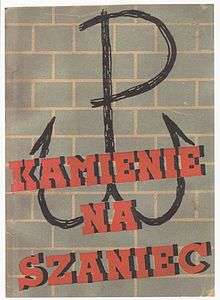Stones for the Rampart
Kamienie na szaniec (lit. Stones for the Rampart, also translated as Stones on the Barricade) is a 1943 non-fiction novel by Polish writer Aleksander Kamiński. Published by the Polish underground press during the World War II occupation of Poland, the book describes the acts of sabotage and armed resistance carried out by the Polish underground scout movement, the Gray Ranks, of whom Kamiński was one of the instructors and leaders.
 | |
| Author | Aleksander Kamiński |
|---|---|
| Original title | Kamienie na szaniec |
| Country | Poland |
| Language | Polish |
| Subject | Small sabotage, Gray Ranks |
| Genre | Drama, war, non-fiction |
| Publisher | Polish underground press |
Publication date | July 1943 |
Already immensely popular during World War II, after the war the book entered the canon of Polish literature and remains a recommended reading text for Polish students in the secondary school curriculum. It was adapted into two feature films, in 1978 and in 2014.
Origin
Kamienie na szaniec was published by the Polish underground press in 1943, during the period of German occupation of Poland in World War II.[1] The author Aleksander Kamiński was a member of the Polish Armia Krajowa (Home Army) resistance movement, editor of the underground Biuletyn Informacyjny magazine, and one of the instructors and leaders of the Polish underground scout movement, the Gray Ranks, which took an active role in the resistance through various acts of minor resistance known as small sabotage.[1] Kamiński based his story on the memoirs of Tadeusz Zawadzki ("Zośka"), a 22-year-old member of the Gray Ranks.[2]
Plot
The story portrayed in the book is a slightly fictionalized account of real lives of Gray Rank members (known by their noms-de-guerre of "Rudy", "Zośka", and "Alek"), with the final act centred on the Operation Arsenal. The book tells the story of a group of Polish boy-scouts taking part in resistance movements in nazi-occupied Warsaw. A major part of the book revolves around trying to rescue "Rudy" from Gestapo captivity. Despite the success of the operation, "Rudy" dies shortly afterwards from grave injuries caused by torture during German interrogations, with "Zośka" by his side. "Alek" dies at the same time from wounds sustained during the rescue, while "Zośka" is killed a few months after in another operation.[3]
Significance
The title of the book comes from Testament mój (My Testament), a poem by Juliusz Słowacki, and refers to the insurrectionist traditions of Polish romanticism.[4] In that book, Kamiński redefines the meaning of scouting in times of military conflict.[5] According to the critic Maciej Górny, describing the book's role in the complexity of subsequent events of Polish history, it became "one of the main Polish narratives of the Second World War, appealing to sentiments of national heroism as well as contributing to symbolic self-victimization."[3]
The relevant passage from Słowacki's poem is:
But I beseech you – there is hope while there is breath.
Do lead the nation with a wisdom’s torch held high,
And one by one, if needed be, go straight to death,As God-hurled stones that densely over ramparts fly.[6]
Publication
Kamienie na szaniec was published in Poland twice before the war ended, and 17 times before 1993.[7] The book was published in English as Stones for the Rampart: The story of two lads in the Polish underground movement in 1944, and in Czech in 1948.[8]
Reception
Despite difficulties in distribution, it quickly gained popularity in occupied Poland.[5] Over the years the book, described as "canonical", became a recommended reading text for Polish students in the secondary school curriculum.[9][10] At first, however, the book's popularity had been of concern to the Polish communist authorities after the war,[11] due to their ambivalent or even hostile attitude towards the Home Army tradition.[7] In the first years of communist rule, it was either criticized as irresponsible, or suppressed.[3] It was republished following the liberalization of 1956,[7] and eventually it was included in the recommended texts for schoolchildren even before the fall of communism in Poland.[9]
Film adaptations
The book was made into a movie, Akcja pod Arsenałem, directed by Jan Łomnicki in 1978.[3]
A new film based on the book, directed by Robert Gliński,[12] was released in Poland on March 7, 2014.[13] It was promoted by the song "4:30" by Polish singer Dawid Podsiadło.
See also
References
- Halina Lerski (1996). Historical Dictionary of Poland, 966–1945. ABC-CLIO. p. 241. ISBN 978-0-313-03456-5.
- Janusz Wojtycza; Muzeum Harcerstwa (2006). Harcerski słownik biograficzny. Muzeum Harcerstwa. p. 32. ISBN 978-83-923571-0-0.
- Ahmet Ersoy; Maciej Górny; Vangelis Kechriotis (2010). Modernism: Representations of National Culture. Central European University Press. p. 243. ISBN 978-963-7326-64-6.
- Kazimierz Doktór (1997). Socjologia: teoria i działanie : księga pamiątkowa ku czci Władysława Markiewicza. Wydawn. IFiS PAN. p. 317. ISBN 978-83-86166-79-4.
- Ahmet Ersoy; Maciej Górny; Vangelis Kechriotis (2010). Modernism: Representations of National Culture. Central European University Press. p. 242. ISBN 978-963-7326-64-6.
- My Testament at Wikisource.
- Antonina Kłoskowska (2001). National Cultures at the Grass-root Level. Central European University Press. p. 305. ISBN 978-963-9116-83-2.
- Grzegorz Mazur (1987). Biuro Informacji i Propagandy Służby Zwycięstwu Polski-Związku Walki Zbrojnej-Armii Krajowej 1939–1945. Instytut Wydawniczy Pax. p. 188.
- Antonina Kłoskowska (2001). National Cultures at the Grass-root Level. Central European University Press. p. 324. ISBN 978-963-9116-83-2.
- Ewa Ochman (2013). Post-Communist Poland: Contested Pasts and Future Identities. Routledge. p. 187. ISBN 978-1-135-91593-3.
- Aleksandra Ziolkowska-Boehm (2013). Melchior Wankowicz: Poland’s Master of the Written Word. Lexington Books. p. 95. ISBN 978-0-7391-7591-0.
- "Ruszyły zdjęcia do "Kamieni na Szaniec"". Tvnwarszawa.tvn24.pl. Retrieved 2013-08-24.
- Monolith Films (2014-01-20). "KAMIENIE NA SZANIEC - zwiastun ostateczny (HD) - w kinach od 7 marca 2014!". YouTube. Retrieved 2014-07-28.
External links
- Official website (film) (in Polish)
- Stones for the Rampart: The story of two lads in the Polish underground movement at WorldCat


